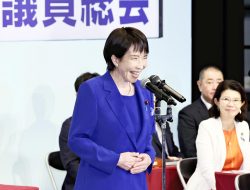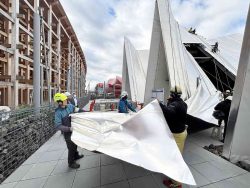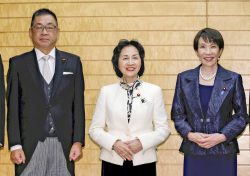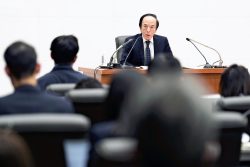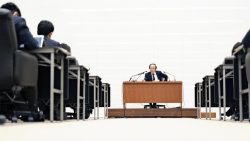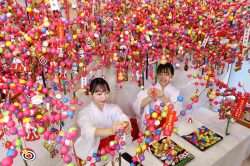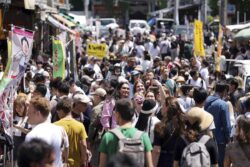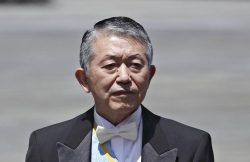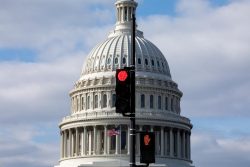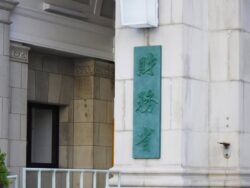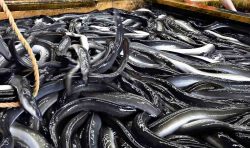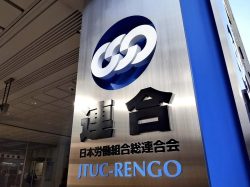
Then Prime Minister Toshiki Kaifu speaks at the Liberal Democratic Party study meeting in Ito, Shizuoka Prefecture, on Sept. 30, 1989.
8:00 JST, February 22, 2025
It was very characteristic of U.S. President Donald Trump when he said: “The golden age of America begins right now. Our country will flourish and be respected again all over the world.” Although he spoke with solid conviction in his inaugural address, I have no idea whether the Trump administration can actually realize an American golden age.
“Golden age” is a hyperbolic expression, and dictionaries say the term is especially used for times in the past. So, it might be meaningful to look back on Japanese history and think about a golden age in Japan.
If we adopt a definition of a golden age as described by Trump, prosperity and international status are the decisive factors. Opinions may differ, but many people share the view that the 1980s were a plausible golden age for Japan, when Japanese economic power was the strongest it had ever been.
When Ezra Vogel’s bestselling book “Japan as Number One” was published in Japan in 1979, it gave Japanese people a sense of confidence through the next decade. During the 1980s the Japanese economy rose toward its peak. In 1988, Japan was the world’s second largest economy, and its gross domestic product that year grew by more than 6%, a rate it has never reached again. Among the world’s 10 biggest corporations in terms of aggregate market value, nine were Japanese. Big banks in particular overwhelmed other nations’ companies. Some may call it a gilded age rather than a golden age. Actually, it was a bubble economy that was doomed to collapse.
Conventional wisdom has it that the private sector was the major driver of the bubble economy. Euphoria and recklessness on the part of big banks, securities firms and ordinary businesses were to blame. But it might be more accurate to say that the bubble and its collapse were caused by a series of flawed financial and economic policies. Even monetary policy under the old Bank of Japan Law had been strongly influenced by the government.
You may consider it the wisdom of hindsight, but I wonder why the Japanese government at that time, led by Prime Minister Toshiki Kaifu, could not avoid the bursting of the bubble and engineer a soft landing. Kaifu was in office from 1989 to 1991, the most critical time for dealing with the bubble economy.
Regrettably, his Cabinet was too incompetent to cope with these unprecedented crises. Although popular among the people for his sincere personality, he was criticized for a lack of a leadership and an inability to make hard decisions.
Kaifu took office as president of the ruling Liberal Democratic Party less than a month after the LDP suffered a devastating defeat in the House of Councillors election. This was due to the Recruit scandal in which unlisted stocks were transferred to many leading LDP politicians and high-ranking officials of government ministries, some of whom were also involved in cases of bribery. The LDP was harshly criticized by the opposition parties and the news media, and there was a backlash in the form of public sentiment against the party and a distrust of politics.
When the Kaifu administration was inaugurated, many influential LDP politicians who had accepted unlisted stocks but had not been criminally charged were considered “tainted” and were excluded from ministerial and party posts. “Cleanness” with regard to money issues, rather than ability or experience, was a key criterion for choosing the prime minister and ministers.
So, the Kaifu Cabinet was not thought to be a full-fledged one. The seasoned political leader who succeeded him, Kiichi Miyazawa, called Kaifu a “relief pitcher.” This meant he was not an ordinary but a stopgap prime minister.
If Kaifu had taken office in a quieter time, his Cabinet would be remembered for some successes. But, while he was in power, a historical turning point had come. Domestically, the bubble economy was in its last stages and the financial authorities should have taken a more meticulous approach to alleviating the pain when the bubble burst. In addition, Japan had to try to rebuild its economic structures without losing its high productivity.
Internationally, the Cold War ended, the first Gulf War took place and the world order was in flux. Japan needed to take on a more international role, which was unprecedented in the years following the end of World War II. Moreover, economic friction between Japan and the United States had escalated, and after hard negotiations with the U.S. government, productive Japanese industries such as the semiconductor industry lost the momentum to lead the world.
Facing such formidable challenges, the Kaifu Cabinet could achieve only inadequate results. There are no “ifs” in history. No one knows whether someone other than Kaifu, even the best and the brightest, if they had been in power at that time, could have managed to do what was necessary. Unfortunately, Japan had vulnerability in its leadership when it needed strength and ability more than ever. The golden age did not last long and, in fact, turned into a tragedy.
The collapse of the speculative bubble was such a blow that the Japanese economy fell into chaos and long-term stagnation. Not only the Kaifu administration, but subsequent ones repeatedly mismanaged the economy. Though Japan worked on various reforms, it took more than three decades to recover from a sluggish economy amid a decline of economic power and the aging of the population. One of the costs of “the lost three decades” was the so-called employment ice age. So many young people who had wanted to enter the workforce during those years lost the chance to stabilize their lives and show their talents in proper work environments.
Coincidentally, the recent political situation surrounding the slush fund scandal which has hit the LDP and weakened Prime Minister Shigeru Ishiba’s Cabinet reminds us of what happened after the Recruit scandal. I do not want to be a fatalist who thinks that a repeat of the history of Kaifu’s Cabinet is unavoidable, but I feel that few lessons have been learned to avoid the same kind of costly mistakes. If that feeling is correct, all we can do now is pray that nothing disastrous happens.
Political Pulse appears every Saturday.
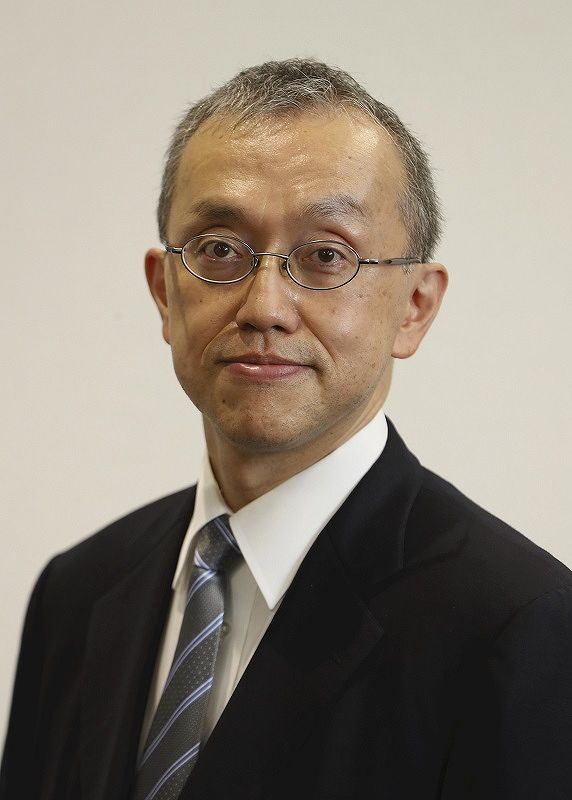
Takayuki Tanaka
Takayuki Tanaka is the president of The Yomiuri Shimbun, Osaka. His previous posts included managing editor of The Yomiuri Shimbun, Tokyo.
"Editorial & Columns" POPULAR ARTICLE
-

Violations of Subcontract Law: Major Automakers Must Eliminate Old Practices
-

Local Governments’ Tax Revenues: Devise Ways to Correct Imbalances in Tax Sources
-
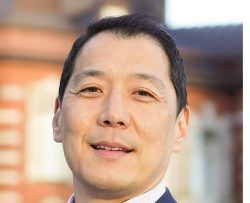
5 Japanese Business Dinner Mistakes to Avoid — and What They Taught Me About Business in Japan
-

Heavy Rains in Asia: Support for Victims, Flood-Control Measures Urgently Needed
-

New Nuclear Threat: China Seeking to Follow U.S., Russia in Military Expansion
JN ACCESS RANKING
-
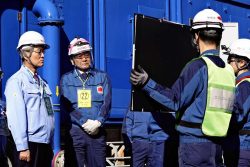
Keidanren Chairman Yoshinobu Tsutsui Visits Kashiwazaki-Kariwa Nuclear Power Plant; Inspects New Emergency Safety System
-
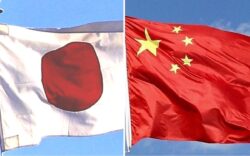
Imports of Rare Earths from China Facing Delays, May Be Caused by Deterioration of Japan-China Relations
-
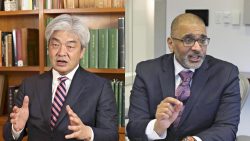
University of Tokyo Professor Discusses Japanese Economic Security in Interview Ahead of Forum
-
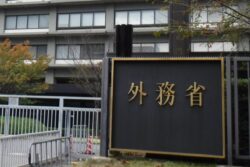
Japan Pulls out of Vietnam Nuclear Project, Complicating Hanoi’s Power Plans
-
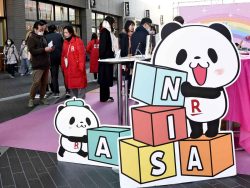
Govt Aims to Expand NISA Program Lineup, Abolish Age Restriction



